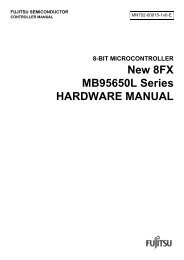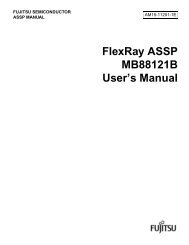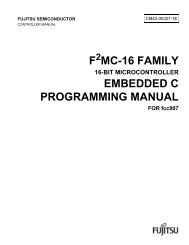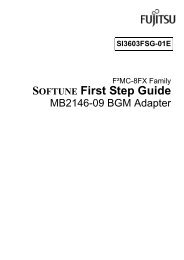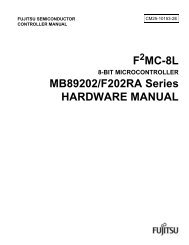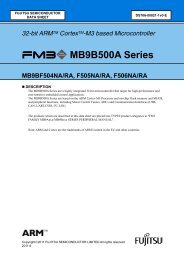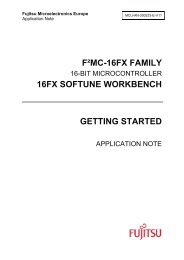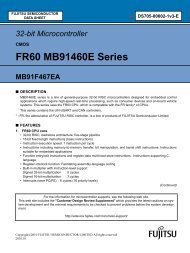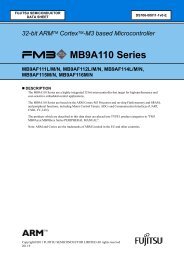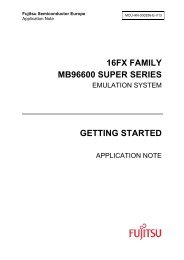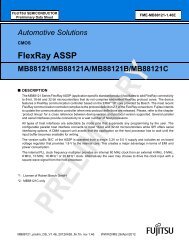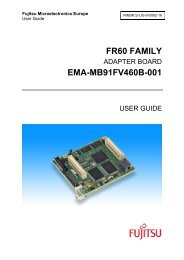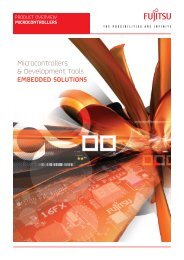FM3 MB9B500 Series - Microcontrollers - Fujitsu
FM3 MB9B500 Series - Microcontrollers - Fujitsu
FM3 MB9B500 Series - Microcontrollers - Fujitsu
You also want an ePaper? Increase the reach of your titles
YUMPU automatically turns print PDFs into web optimized ePapers that Google loves.
<strong>MB9B500</strong> <strong>Series</strong><br />
Precautions for Package Mounting<br />
Package mounting may be either lead insertion type or surface mount type. In either case, for heat resistance<br />
during soldering, you should only mount under FUJITSU's recommended conditions. For detailed<br />
information about mount conditions, contact your FUJITSU sales representative.<br />
・ Lead Insertion Type<br />
Mounting of lead insertion type packages onto printed circuit boards may be done by two methods:<br />
direct soldering on the board, or mounting by using a socket.<br />
Direct mounting onto boards normally involves processes for inserting leads into through-holes on the<br />
board and using the flow soldering (wave soldering) method of applying liquid solder.<br />
In this case, the soldering process usually causes leads to be subjected to thermal stress in excess of the<br />
absolute ratings for storage temperature. Mounting processes should conform to FUJITSU<br />
recommended mounting conditions.<br />
If socket mounting is used, differences in surface treatment of the socket contacts and IC lead surfaces<br />
can lead to contact deterioration after long periods. For this reason it is recommended that the surface<br />
treatment of socket contacts and IC leads be verified before mounting.<br />
・ Surface Mount Type<br />
Surface mount packaging has longer and thinner leads than lead-insertion packaging, and therefore leads<br />
are more easily deformed or bent. The use of packages with higher pin counts and narrower pin pitch<br />
results in increased susceptibility to open connections caused by deformed pins, or shorting due to<br />
solder bridges.<br />
You must use appropriate mounting techniques. FUJITSU recommends the solder reflow method, and<br />
has established a ranking of mounting conditions for each product. Users are advised to mount packages<br />
in accordance with FUJITSU ranking of recommended conditions.<br />
・ Lead-Free Packaging<br />
Note: When ball grid array (BGA) packages with Sn-Ag-Cu balls are mounted using Sn-Pb eutectic<br />
soldering, junction strength may be reduced under some conditions of use.<br />
・ Storage of Semiconductor Devices<br />
Because plastic chip packages are formed from plastic resins, exposure to natural environmental<br />
conditions will cause absorption of moisture. During mounting, the application of heat to a package that<br />
has absorbed moisture can cause surfaces to peel, reducing moisture resistance and causing packages to<br />
crack. To prevent, do the following:<br />
・ Avoid exposure to rapid temperature changes, which cause moisture to condense inside the product.<br />
Store products in locations where temperature changes are slight.<br />
・ Use dry boxes for product storage. Products should be stored below 70% relative humidity, and at<br />
temperatures between 5 C and 30 C When you open Dry Package that recommends humidity 40%<br />
to 70% relative humidity.<br />
・ When necessary, FUJITSU packages semiconductor devices in highly moisture-resistant aluminum<br />
laminate bags, with a silica gel desiccant. Devices should be sealed in their aluminum laminate bags<br />
for storage.<br />
・ Avoid storing packages where they are exposed to corrosive gases or high levels of dust.<br />
・ Baking<br />
Packages that have absorbed moisture may be de-moisturized by baking (heat drying). Follow the<br />
FUJITSU recommended conditions for baking.<br />
Condition:+125 C/24 h<br />
DS706-00010-1v0-E<br />
47



